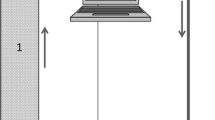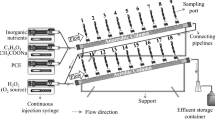Abstract
This paper investigates effects of combining thermal and biological remediation, based on laboratory studies of trichloroethene (TCE) degradation. Aquifer material was collected 6 months after terminating a full-scale Electrical Resistance Heating (ERH), when the site had cooled from approximately 100°C to 40°C. The aquifer material was used to construct bioaugmented microcosms amended with the mixed anaerobic dechlorinating culture, KB-1TM, and an electron donor (5 mM lactate). Microcosms were bioaugmented during cooling at 40, 30, 20, and 10°C, as temperatures continually decreased during laboratory incubation. Redox conditions were generally methanogenic, and electron donors were present to support dechlorination. For microcosms bioaugmented at 10°C and 20°C, dechlorination stalled at cis-dichloroethene (cDCE) and vinyl chloride (VC) 150 days after bioaugmentation. However, within 300 days of incubation ethene was produced in the majority of these microcosms. In contrast, dechlorination was rapid and complete in microcosms bioaugmented at 30°C. Microcosms bioaugmented at 40°C also showed rapid dechlorination, but stalled at cDCE with partial VC and ethene production, even after 150 days of incubation when the temperature had decreased to 10°C. These results suggest that sequential bioremediation of TCE is possible in field-scale thermal treatments after donor addition and bioaugmentation and that the optimal bioaugmentation temperature is approximately 30°C. When biological and thermal remediations are to be applied at the same location, three bioremediation approaches could be considered: (a) treating TCE in perimeter areas outside the source zone at temperatures of approximately 30°C; (b) polishing TCE concentrations in the original source zone during cooling from approximately 30°C to ambient groundwater temperatures; and (c) using bioremediation in downgradient areas taking advantages of the higher temperature and potential release of organic matter.





Similar content being viewed by others
References
Bradley PM, Chapelle FH (1999) Role for acetotrophic methanogens in methanogenic biodegradation of vinyl chloride. Environ Sci Technol 33(19):3473–3476
Bradley PM (2003) History and ecology of chloroethene biodegradation: a review. Biorem J 7(2):81–109
Cupples AM, Spormann AM, McCarty PL (2003) Growth of a Dehalococcoides-like microorganism on vinyl chloride and cis-dichloroethene as eletron acceptors as determined by competetive PCR. Appl Environ Microbiol 69(2):953–959
Cupples AM, Spormann AM, McCarty PL (2004) Comparative evaluation of chloroethene dechlorination to ethene by Dehalococcoides-like microorganisms. Environ Sci Technol 38(18):4768–4774
Davis E (1998) Steam injection for soil and aquifer remediation. EPA/540/S-97/505 Robert S. Kerr Environmental Research Laboratory
Duhamel M, Edwards EA (2006) Microbial composition of chlorinated ethene-degrading cultures dominated by Dehalococcoides. FEMS Microbiol Ecol 58:538–549
Duhamel M, Mo K, Edwards EA (2004) Characterization of a highly enriched Dehalococcoides-containing culture that grows on vinyl chloride and trichloroethene. Appl Environ Microb 70(9):5538–5545
Duhamel M (2005) Community structure and dynamics of chlorinated ethene-degrading enrichment cultures, Ph.D. thesis, University of Toronto
Ellis DE, Lutz EJ, Odom JM et al (2000) Bioaugmentation for accelerated in-situ anaerobic bioremediation. Environ Sci Technol 34(11):2254–2260
Friis AK (2006) The potential for reductive dechlorination after thermal treatment of TCE-contaminated aquifers. PhD thesis. Technical University of Denmark.
Friis AK, Albrechtsen HJ, Heron G et al (2005) Redox processes and release of organic matter after thermal treatment of a TCE-contaminated aquifer. Environ Sci Technol 39(15):5787–5795
Friis AK, Albrechtsen H-J, Cox E, Bjerg PL (2006a) The potential for bioaugmentation after thermal treatment of TCE-contaminated groundwater: Laboratory experiments. J Contam Hydrol 88:235–248
Friis AK, Heron G, Albrechtsen HJ et al (2006b) Anaerobic dechlorination and redox activities after full-scale Electrical Resistance Heating (ERH) of a TCE-contaminated aquifer. J Contam Hydrol 88:219–234
Friis AK, Edwards E, Albrechtsen H-J et al (2007a) Dechloration after thermal treatment of a TCE-contaminated aquifer: laboratory experiments. Chemosphere doi:10.1016/j.chemosphere.2006.10.012
Friis AK, Heimann A, Jakobsen R et al (2007b) Temperature dependence of anaerobic TCE-dechlorination in a highly enriched Dehalococcoides-containing culture. Water Res 41:355–364
Haston ZC, McCarty PL (1999) Chlorinated ethene half velocity coefficients (K S ) for Reductive dehlogenation. Environ Sci Technol 33(2):223–226
He JZ, Ritalahti KM, Aiello MR et al (2003) Complete detoxification of vinyl chloride by an anaerobic enrichment culture and identification of the reductively dechlorinating population as a Dehalococcoides species. Appl Environ Microb 69(2):996–1003
He JZ, Sung Y, Dollhopf ME et al (2002) Acetate versus hydrogen as direct electron donors to stimulate the microbial reductive dechlorination process at chloroethene-contaminated sites. Environ Sci Technol 36(18):3945–3952
Hendrickson ER, Payne JA, Young RM et al (2002) Molecular analysis of Dehalococcoides 16S ribosomal DNA from chloroethene-contaminated sites throughout North America and Europe. Appl Environ Microb 68(2):485–495
Heron G, Carroll S, Nielsen SGD (2005) Full-scale removal of DNAPL constituents using steam enhanced extraction and electrical resistance heating. Ground Water Monit R 25(4):92–107
Heron G, Christensen TH, Enfield CG (1998) Henry’s law constant for trichloroethylene between 10 and 95 degrees C. Environ Sci Technol 32(10):1433–1437
Holliger C, Schraa G, Stams AJM et al (1993) A highly purified enrichment culture couples the reductive dechlorination of tetrachloroethene to growth. Appl Environ Microbiol 59(9):2991–2997
Holliger C, Wohlfarth G, Diekert G (1998) Reductive dechlorination in the energy metabolism of anaerobic bacteria. Fems Microbiol Rev 22(5):383–398
Krauter P, MacQueen D, Bishop D (1995) Effects on subsurface electrical heating and steam injection on the indigenous microbial community, UCRL-JC-122299. Lawrence Livermore National Laboratory, Livermore CA, USA
Larsen TH, Schlag R, Andersen KL et al (2004) Dampoprensning af klorerede opløsningsmidler på tidligere industrigrund i Hedehusene 877 Miljøstyrelsen, Danish ministry of the Environment, Copenhagen
Lu XX, Tao S, Bosma T et al (2001) Characteristic hydrogen concentrations for various redox processes in batch study. J Environ Sci Heal A 36(9):1725–1734
Major DW, McMaster ML, Cox EE et al (2002) Field demonstration of successful bioaugmentation to achieve dechlorination of tetrachloroethene to ethene. Environ Sci Technol 36(23):5106–5116
Maymo-Gatell X, Nijenhuis I, Zinder SH (2001) Reductive dechlorination of cis-1,2-dichloroethene and vinyl chloride by Dehalococcoides ethenogenes. Environ Sci Technol 35(3):516–521
Shimotori T, Arnold WA (2003) Measurement and estimation of Henry’s law constants of chlorinated ethylenes in aqueous surfactant solutions. J Chem Eng Data 48(2):253–261
Staudinger J, Roberts PV (2001) A critical compilation of Henry’s law constant temperature dependence relations for organic compounds in dilute aqueous solutions. Chemosphere 44(4):561–576
Sung Y, Ritalahti KM, Sanford RA et al. (2003) Characterization of two tetrachloroethene-reducing, acetate-oxidizing anerobic bacteria and their description as Desulfuromonas michiganensis sp nov. Appl Environ Microb 69(5):2964–2974
U.S. Army Corps of Engineers S. D. (2002) Field investigation report. EGDY phase II RI, Fort Lewis Logistics Center Superfund Site. Seattle, WA
Wilhelm E, Battino R, Wilcock RJ (1977) Low-pressure solubility of gases in liquid water. Chem Rev 77(2):219–262
Yang YR, McCarty PL (1998) Competition for hydrogen within a chlorinated solvent dehalogenating anaerobic mixed culture. Environ Sci Techn 32(22):3591–3597
Yu SH, Dolan ME, Semprini L (2005) Kinetics and inhibition of reductive dechlorination of chlorinated ethylenes by two different mixed cultures. Environ Sci Techn 39(1):195–205
Zehnder AJB (1988) Biology of anaerobic microorganisms. John Wiley & Sons, Inc. New York
Acknowledgments
This research was supported by Technical University of Denmark through a Ph.D. scholarship. Additional funds were obtained from COWIfonden. The authors would like to thank Jens Schaarup Sørensen at Institute of Environment & Resources, Technical University of Denmark for technical assistance as well as Thermal Remediation Systems, and U.S. Army Corps of Engineers, Seattle District for providing the field site and help with sampling and logistics. SIREM Laboratories, Ontario, Canada is acknowledged for providing the KB-1TM-culture used in the microcosm experiments.
Author information
Authors and Affiliations
Corresponding author
Rights and permissions
About this article
Cite this article
Friis, A.K., Kofoed, J.L.L., Heron, G. et al. Microcosm evaluation of bioaugmentation after field-scale thermal treatment of a TCE-contaminated aquifer. Biodegradation 18, 661–674 (2007). https://doi.org/10.1007/s10532-006-9098-y
Received:
Accepted:
Published:
Issue Date:
DOI: https://doi.org/10.1007/s10532-006-9098-y




